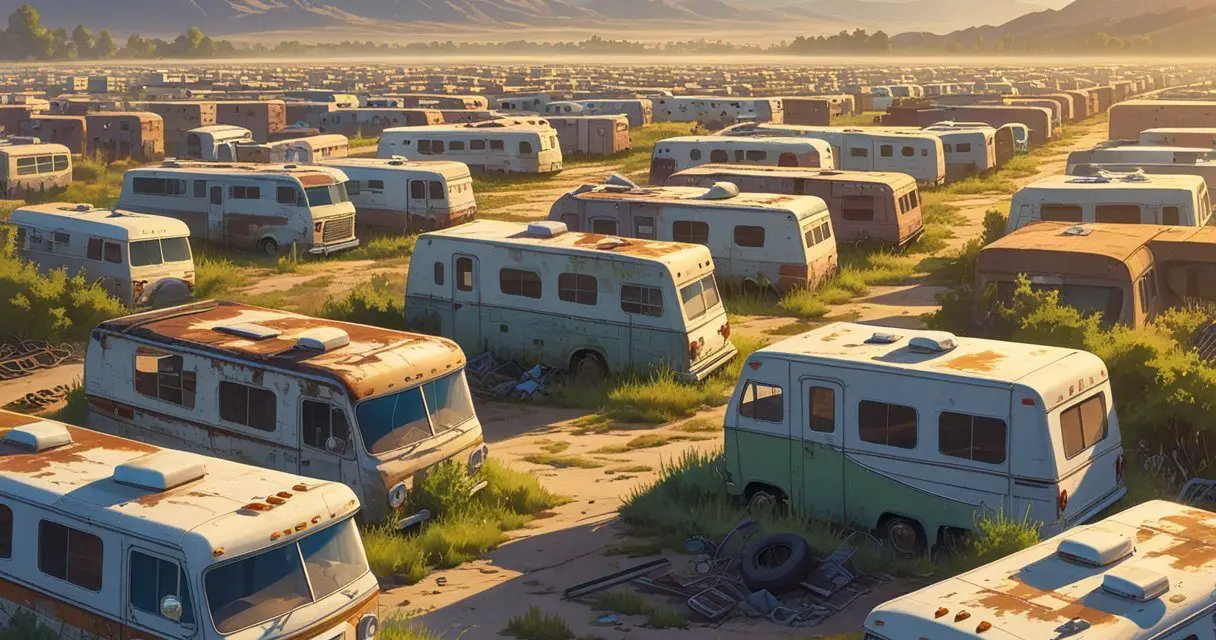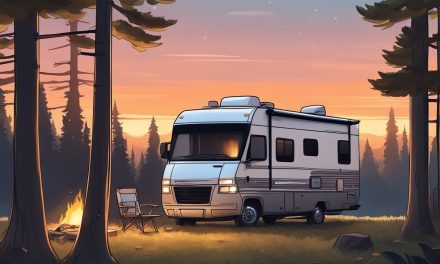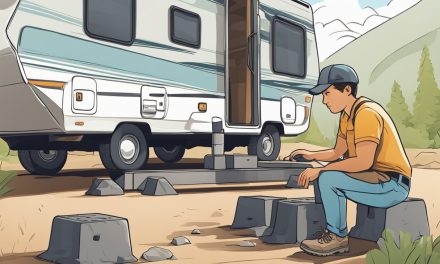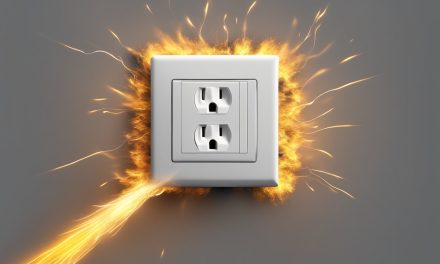Would you like to save this article?
The recreational vehicle industry is witnessing the biggest liquidation event in its history. Here’s what you need to know before buying your next RV.
The RV world has turned upside down in 2025, and if you’re thinking about buying, you’re looking at the opportunity of a lifetime. Nearly 3 million like-new RVs are flooding the market, creating a buyer’s paradise that hasn’t been seen since the 2008 recession. But here’s the catch: you need to know exactly what you’re looking at to avoid the hidden traps.
This isn’t just about getting a good deal—it’s about understanding why prices are crashing so hard that dealers are literally paying people to take inventory off their hands. The same pandemic boom that created waiting lists is now creating liquidation sales. From repossessed motorhomes to factory-fresh units sold at auction prices, the landscape has completely changed.
What started as whispers in dealer chat rooms has become an industry-wide fire sale. You’ll discover why timing your purchase correctly could save you $50,000 or more on your dream RV, and how to spot the difference between genuine bargains and potential nightmares waiting to happen.
1. The Great RV Dump: 3 Million Units Hit the Market
The numbers tell a story that sounds almost impossible to believe. In 2025, nearly 3 million RVs have suddenly appeared for sale, turning what was once a seller’s market into a buyer’s feeding frenzy. This isn’t gradual market correction—it’s a dam bursting.
Storage lots that were empty during the pandemic boom are now overflowing with gleaming motorhomes and travel trailers. Manufacturers who bragged about year-long waiting lists are now begging brokers to take inventory at any price. Auction calendars have doubled overnight, with some facilities running sales seven days a week just to handle the volume.
The scale feels biblical because it represents years of pent-up production finally hitting reality. When stimulus checks dried up and gas prices soared, buyers vanished faster than morning dew. But the factories kept running, dealers kept ordering, and the pipeline kept filling until it burst.
| Market Indicator | 2023 | 2024 | 2025 |
|---|---|---|---|
| Available Inventory | 45,000 units | 180,000 units | 2.8M+ units |
| Average Days on Lot | 22 days | 67 days | 180+ days |
| Price Reductions | 5-8% | 15-25% | 35-50% |
Here’s where it gets interesting: You’re not just looking at regular market forces—you’re witnessing what happens when an entire industry gets caught with their pants down. Every gleaming RV sitting under those halogen lights represents someone’s broken dream and your potential goldmine.
2. Pandemic Hangover: When Dreams Meet Reality
Remember 2020 when everyone thought living in an RV was going to solve all of life’s problems? Those same families who mortgaged their futures for rolling sanctuaries are now facing the harsh mathematics of ownership. The pandemic created the biggest buying spree in RV history, and now the bills are coming due.
Stimulus checks made everyone feel rich, cheap credit made everything seem affordable, and social media made van life look effortless. Factories that had been cautious suddenly went into overdrive, running double shifts to chase demand that seemed endless. Dealers signed contracts assuming the wave would never crest.
But waves always crest, and this one crashed hard. Fuel costs soared past $5 per gallon in many areas, interest rates climbed from 3% to over 8%, and those monthly payments that seemed manageable became crushing. The same buyers who lined up at dawn to buy RVs quietly started avoiding dealer phone calls.
According to industry data, RV loan delinquencies increased by 34% in 2024, with repossessions following close behind. The dream rig that was supposed to provide freedom became a financial anchor dragging families underwater.
Your opportunity lies in understanding this psychology. Every seller you meet is dealing with some combination of financial pressure, buyer’s remorse, or life changes that make RV ownership impossible. They need to sell more than you need to buy—and that’s pure negotiating gold.
3. Floor Plan Prison: How Dealers Became Trapped
Here’s something most RV buyers never understand: dealers don’t actually own most of the inventory sitting on their lots. They’re using something called floor plan financing, which is essentially a credit line that lets them stock RVs they haven’t sold yet. When the market was hot, this system worked like magic. Now it’s become a financial prison.
Every unsold RV accumulates daily interest like a taxi meter that never stops running. During the boom, dealers could flip inventory fast enough that interest costs were negligible. Today, with RVs sitting on lots for 180+ days, those interest payments are bleeding dealers dry.
The numbers are staggering: A $100,000 motorhome sitting unsold for six months can accumulate over $4,000 in floor plan interest at current rates. Multiply that by hundreds of units, and you’ll understand why dealers are having panic attacks.
Banks are making the situation worse by cutting credit lines and demanding higher collateral values. When auction prices drop, dealers get margin calls forcing them to either pay cash or reduce inventory immediately. This creates the desperate selling environment that smart buyers can exploit.
What this means for you: Dealers trapped in floor plan financing will negotiate harder than ever before. They’re not just trying to make a profit—they’re trying to stop the bleeding. Understanding their pain gives you incredible leverage.
4. Auction Reality Check: Where Dreams Go to Die
Walk through any RV auction yard right now, and you’ll see the truth that marketing brochures can’t hide. These aren’t just regular auctions—they’re financial autopsies performed under fluorescent lights. Row after row of nearly new fifth wheels and motorhomes sell for pennies on the dollar.
The hammer falls lower every week as values collapse faster than a house of cards in a hurricane. A 2023 Class A motorhome that retailed for $180,000 might sell for $85,000 at auction—and that’s if it finds a buyer. Dealers attend these auctions not to buy, but to unload their own inventory for whatever they can get.
Clearance rates have dropped from over 80% to under 50% at many auction houses. This means half the RVs brought to auction don’t even reach their reserve prices. When auctioneers can’t give away nearly new RVs, you know the market has fundamentally broken.
| RV Class | 2023 Avg Auction Price | 2025 Avg Auction Price | % Drop |
|---|---|---|---|
| Class A Motorhomes | $125,000 | $72,000 | 42% |
| Class C Motorhomes | $89,000 | $58,000 | 35% |
| Travel Trailers | $45,000 | $28,000 | 38% |
| Fifth Wheels | $78,000 | $49,000 | 37% |
Here’s your insider advantage: Auction results set the floor for all RV pricing. When you’re negotiating with a dealer, mention specific auction results for comparable units. They can’t argue with hammer prices—they know you know the real market value.
5. Repo Surge: The Dark Side of the RV Dream
The most heartbreaking part of this market collapse is the human cost. RV repossessions have increased by over 40% in 2024-2025, creating a steady stream of previously loved motorhomes flowing into auctions and dealer lots. These aren’t just statistics—they’re families who stretched 10-year loans to afford their dream and couldn’t make it work.
Banks are accelerating repossessions to salvage whatever equity remains as resale values evaporate. Each repo becomes another unit flooding the wholesale market, which suppresses prices even further. It’s a vicious cycle that feeds on itself.
What makes this especially painful is that many of these repossessed RVs are nearly new. Families bought them during the pandemic boom, used them for a few trips, then couldn’t afford the payments when economic reality hit. The average repossessed RV has less than 15,000 miles on it.
For buyers, repos represent incredible opportunities with a dark backstory. These units often come with full maintenance records and low mileage, but they’re priced to move quickly. Banks don’t want to be in the RV business—they want their money back.
Your ethical approach should be simple: These tragic situations create legitimate buying opportunities, but never take advantage of desperate sellers. Pay fair market value based on current conditions, not emotional manipulation.
6. Zombie RVs: When Bargains Become Nightmares
Not every deal in this collapsed market is what it appears to be. Hidden among the legitimate bargains are “zombie RVs”—units that look perfect but hide fatal flaws. These damaged RVs have been cosmetically repaired and quietly resold through title washing and creative paperwork.
Hurricane damage, flood destruction, and hail storms have created thousands of damaged RVs that unscrupulous dealers are repairing and reselling. The exterior might look flawless, but moisture seeps into insulation where mold spreads like a secret infection. Electrical systems corrode silently until critical systems fail without warning.
The National Insurance Crime Bureau reports a 28% increase in flood-damaged recreational vehicles entering the used market in 2024-2025. Many buyers never bother to check VIN histories or demand moisture tests.
| Warning Signs of Zombie RVs | What to Check |
|---|---|
| Musty or chemical odors | Professional moisture test |
| Mismatched paint or panels | NICB database search |
| New appliances in old RVs | Complete VIN history report |
| Unusually low prices | Detailed pre-purchase inspection |
Your protection strategy: Never trust appearances in this market. Demand VIN verification against federal databases, insist on professional inspections, and walk away from any deal that feels too good to be true. A $20,000 bargain that needs $30,000 in hidden repairs isn’t a bargain—it’s a financial trap.
7. Perfect Storm Timing: When to Strike for Maximum Savings
Smart RV buyers understand that timing trumps negotiation skills in this market. Two specific windows offer maximum savings: late winter when dealers are desperate to reduce floor plan costs, and early autumn when next year’s models make current inventory radioactive.
The late winter window (January-March) catches dealers at their most vulnerable. They’ve been paying floor plan interest on unsold inventory through the slow winter months and need to clear space before spring shipments arrive. This is when you’ll see the deepest price cuts with minimal negotiation.
The autumn window (September-November) occurs when new model years hit the market and current inventory suddenly becomes “last year’s model.” Dealers will slash prices dramatically to avoid carrying 2024 models into 2025.
Industry insiders report that buyers who time their purchases correctly can save 25-40% over MSRP without touching advanced negotiation tactics. It’s not about being a tough negotiator—it’s about showing up when sellers are most motivated.
Current market conditions have created a third window: The “panic sale” window that’s happening right now. With 3 million units flooding the market, every day brings new opportunities for prepared buyers who know how to evaluate deals quickly.
Your timing strategy should be simple: Map dealer desperation, follow auction results, and strike when the numbers align with your budget. Don’t rush perfect opportunities, but don’t hesitate when mathematical certainty presents itself.
SOURCES
- RV Heads YouTube Channel – “MILLIONS of LIKE-NEW RVs Are Now Being DUMPED for Pennies (2025)”
- RV Industry Association (RVIA) – Q1 2025 Shipment Reports
- ConsumerAffairs – RV Industry Statistics 2025
- Statistical Surveys – State of the RV Industry May 2025
- RV Lifestyle – RV Sales Dropping In 2025
- Cox Automotive – Vehicle Repossession Data 2024-2025
- National Insurance Crime Bureau – Flood Vehicle Database
- Moss Adams – Floor Plan Financing Interest Strategies
- Consumer Financial Protection Bureau – Repossession in Auto Finance 2025
- RVBS – The RV Market Reset: 2025 Marks a New Era





